Overview
The Queensland Audit Office (QAO) makes recommendations to state and local government entities to support better delivery of public services and make a difference to the lives of Queenslanders. We focus on many different aspects of public service delivery, and the primary responsibility for implementing our recommendations rests with the relevant organisation to which we have made them.
We share insights on the most common types of recommendations we have made to entities, and the most common types that have not been implemented which highlights some of the common challenges and opportunities facing the public sector. We offer insights as to where entities can improve their systems and practices.
This is the first in what will be an annual report to parliament. Future reports will cover any outstanding recommendations, and recommendations from the following audit year's reports.
Tabled 17 November 2021.

Auditor-General’s foreword
The Queensland Audit Office is in a unique position as the state’s independent auditor. We inform parliament and the people of Queensland about the performance of state and local government entities, and provide advice and insights from our work across the state. Entities are under increasing pressure to deliver more for the community, with new and increasingly complex risks emerging. The perspective we provide enables them to better respond to existing issues, take advantage of improvement opportunities, and prepare for inevitable future challenges.
This is the first yearly report to parliament. It provides a summary of the self-assessments we asked entities to complete on their progress in implementing the performance audit recommendations we made in our 2015–16, 2016–17, and 2017–18 reports to parliament. We started with these reports to allow a reasonable time for implementation.
While we have a role in helping parliament hold entities to account, the desire for continuous improvement and a culture of change ultimately must come from within entities themselves. We ask them if they agree with the recommendations in our reports to parliament, but we cannot force them to implement them.
Our new online self-assessment system enables entities to easily report on their progress. It gives them a record of the recommendations we made to them, shares the recommendations we make more broadly across government, and gives audit committees clarity over their entities’ self-reported status updates. Of note, we have not audited their responses or requested supporting evidence meaning we do not provide assurance over the completeness and accuracy of the reported implementation statuses.
Valuably, our new approach shows us which types of recommendations are not being implemented as quickly or thoroughly as others. This gives us some indications of which areas of government service delivery entities are finding most challenging. It also helps us ensure our future recommendations are as relevant and practicable as possible.
Next year, we will ask entities to report against 2018–19 and 2019–20 recommendations (and thereafter we will add another report year to each of these annual reports). We will also ask for updates on the ones that have been reported in this year’s report as being partially or not implemented.
Over time, these yearly reports will provide insights on trends, challenges and shared learnings. I hope they will give parliamentarians, parliamentary committees, and members of the public a more complete picture of the progress the entities are making in delivering on our recommendations in order to deliver better public services for Queenslanders.
Brendan Worrall
Auditor-General

Report on a page
The Queensland Audit Office (QAO) makes recommendations to state and local government entities to support better delivery of public services and make a difference to the lives of Queenslanders. In this report, we provide an update on entities’ self-assessed progress in implementing the performance audit recommendations we issued to them between 2015–16 and 2017–18. We selected these years to allow enough time for entities to act on our recommendations.
Our analysis of their reported progress against the different types of recommendations we make highlights some of the common challenges and opportunities for the public sector. We offer insights as to where all entities can improve their systems and practices.
Our recommendations focus on many different aspects of public service delivery. We always ensure they are client focused, address the root cause, and add value to the public sector.
What did we examine?

Insights from entities’ responses
Entities reported the following progress for the recommendations that we issued to them:

Appendix B contains a summary of entities' self-assessed progress implementing our recommendations. The best way to explore their reported progress on each recommendation is via our interactive dashboard available on our website at www.qao.qld.gov.au.
|

1. Insights—recommendations and responses
We prioritise our audit activity to focus on where we can make the most difference. The recommendations we give our clients in our reports to parliament are designed to help them improve their service delivery and learn from the experience of others.
The primary responsibility for implementing our recommendations rests with the relevant organisation to which we have made them. We consult with entities on our draft recommendations before we table a report in parliament, and we ask them to confirm whether they agree with them. We cannot make them implement our recommendations, but we can track, report, and share insights on their progress.
For this report, we asked 50 public sector entities, including local governments, to self-assess their progress acting on the performance audit recommendations we issued to them in our 2015–16, 2016–17, and 2017–18 reports to parliament. We received responses between April and June 2021. This report therefore reflects the status of entities' self-assessed progress in implementing our recommendations at that time.
We asked them to make their assessments (using the criteria detailed in Appendix D) on whether each of our recommendations had been fully, partially or not implemented, or were no longer applicable.
Our performance audits focus on known or suspected gaps in public sector performance. They are usually areas of significance that we can influence and that have not been examined by other integrity agencies. Although we examine many different aspects of the public sector, the same findings often emerge, resulting in similar themes.
We analysed all the recommendations we made from 2015 to 2018 to identify those we made most often. This provided a perspective into some of the challenges and opportunities the public sector is facing. We also used this analysis to reflect on the types of recommendations we make—to ensure that they are client-focused (meaning they are tailored to the specific needs and context of each entity) and address the root cause of the issue (not just the symptoms).
Most frequently made recommendations
We grouped the recommendations we made most often into 10 categories. These are shown in Figure 1A.

Note: We acknowledge that some of the categories above, like risk management, form part of governance. We have separated these to allow for richer analysis.
Queensland Audit Office.
Appendix C explains these categories and shows entities’ reported progress against them.
Insights into the recommendations that are most often not fully implemented
We analysed the 10 categories to identify which had the highest number of outstanding recommendations (which in this report includes both partially implemented and not implemented recommendations).
Entities reported that 65 per cent (72) of the 111 outstanding recommendations related to those we made most often: performance monitoring and reporting, governance, and strategic planning.
They also reported limited progress in implementing recommendations aimed at improving interagency coordination and information sharing.
Figure 1B shows the status of the four most common categories of outstanding recommendations.
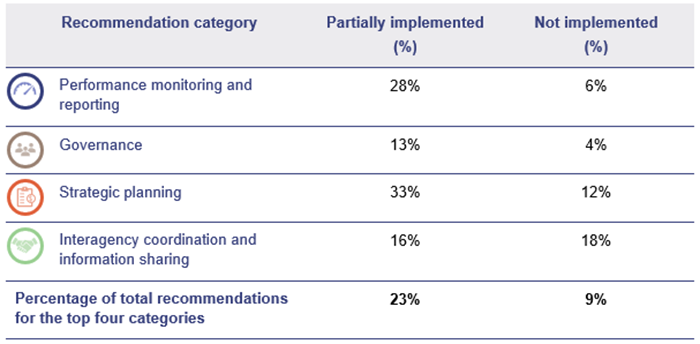
Queensland Audit Office using data self-reported by entities.
The following section provides more detail on these.
Performance monitoring and reporting |
Performance monitoring and reporting practices required the most improvement across the 50 entities we audited. While doing the right things to achieve the intended results and doing things right to make the most of limited resources are both important parts of public service delivery, so is proving they have been done. Entities that do not measure their performance are not managing effectively.
From 2015 to 2018, we made recommendations to many entities about enhancing their performance monitoring and reporting to improve performance and enhance accountability, including that they:
- set performance measures and targets
- measure performance against agreed targets
- regularly report on performance.
Entities reported that 34 per cent (34) of the 101 performance monitoring and reporting recommendations are still in progress or not started. These were from eight reports to parliament.
We issued 10 of these outstanding recommendations more than five years ago. In most instances, our performance monitoring and reporting recommendations are not difficult, time consuming or costly to implement. As such, we expected entities to have implemented all these recommendations. For some entities, this reflects that they are yet to fully embed a culture of continuous improvement.
Governance |
Effective governance can drive economy, efficiency, and effectiveness; and enhance accountability. Entities reported good progress in implementing our governance recommendations—they had implemented 81 per cent of them. However, one entity reported that it had not implemented the governance recommendations from more than five years ago. These were from our audit on the efficiency of operating theatres in Queensland public hospitals.
As outlined in our Forward work plan 2021–24, governance is one of our six areas of priority and focus. We intend to continue to examine entities’ governance arrangements, including their financial reporting practices, structures, and internal controls (which are the systems and processes they use to achieve their objectives, prepare reports, and comply with applicable laws).
Strategic planning |
Strategic planning is vital to the success of any entity. It sets a clear path and brings a sense of purpose and focus.
Key elements of our strategic planning recommendations included:
- ensuring strategic plans had clearly defined objectives
- linking strategic plans to operational plans
- considering how strategic plans align to the Queensland Government’s objectives.
Entities reported that 45 per cent (26) of the 58 strategic planning recommendations were still in progress or not started. Most of these were from our audit on forecasting long-term sustainability in local government. Local governments reported making significant progress, and they were continuing work to fully implement the recommendations.
Interagency coordination and information sharing |
Interagency coordination and information sharing is critical for the effective delivery of public services, particularly if it relies on multiple entities. It reduces duplication and enables better, more efficient services.
Entities reported implementing 55 per cent (27) of the 49 recommendations relating to interagency coordination and information sharing.
Some reported that a lack of collaboration with other entities had affected their ability to implement certain recommendations but did not provide additional context or identify key obstacles. Siloed approaches and competing priorities can be common barriers to interagency coordination and information sharing.
It is not surprising that these recommendations are the least progressed, given they require multiple entities to work together. We have found entities’ governance structures are often not well suited to deliver whole-of-government services.
Insights from entities’ responses
When we asked Queensland public sector entities and local governments to self-assess their progress in implementing our recommendations, it became clear that some lacked the systems and processes for recording, monitoring, and reporting on this. One local government reported that it had limited awareness of the recommendations that we had made to it and had not taken any real action to address them. In some cases, entities had not delegated monitoring responsibility to anyone. This made it difficult for them to determine their progress and report on it. Our enhanced reporting to audit committees on performance audit recommendations gives those charged with governance at each entity full transparency.
|
Insight Entities should ensure they establish systems and processes that assign appropriate accountability for recording, monitoring, and reporting on their progress in implementing our recommendations and those from other reviews and inquiries. This process should be overseen by their audit and risk management committee. |
Some entities reported they had fully implemented recommendations, but because they did not explain the outcomes of their actions (despite being asked to), it is unclear whether they have achieved the intended results or evaluated them. They need to do so to determine whether their actions have resulted in more efficient processes or more effective services, and to help focus future efforts.
|
Insight Entities need to evaluate the outcome of their actions when implementing our recommendations. Timely and robust evaluations help entities determine what has worked well and what they can improve. |
The value of audit committees
Audit committees oversee entities’ internal control environments, financial reporting processes, risk management, and internal and external audit functions. They also hold management to account, monitoring the effectiveness of its performance and overseeing the implementation of audit recommendations.
Where entities have not made progress, audit committees can help management understand what risk is not being mitigated and determine if some assurance (for example, a targeted internal audit) is needed until the risk is mitigated.
Effective audit committees promote accountability, integrity, and transparency, and can help entities continuously improve—becoming more efficient, effective, and economical. The independence of audit committee members is vital to effectively hold management to account.
Our recent report on Effectiveness of audit committees in state government entities (Report 2: 2020–21) provides insights into the current profile and practices of state government audit committees. In 2023–24, we intend to examine the effectiveness of local government audit committees.
We have regularly recommended that all local governments should have an audit committee. Despite this, not all of them do.
We will work with audit committees to ensure they follow up entities that have outstanding recommendations. This includes important recommendations that have a community safety focus, such as those from our report on flood resilience of river catchments.

2. Status of implementation
We make recommendations to entities to help them improve the public services they deliver. The recommendations may address performance gaps, inefficiencies, duplication, and unnecessary risk across the public sector. We may also identify good practice that we recommend other entities consider.
In this section, we discuss entities’ reported progress in implementing the recommendations we issued to them between 2015–16 and 2017–18. We begin with the overall status of implementation, and break it down into years, providing examples for each. We then report on implementation of recommendations in departments, hospital and health services, local governments, and other entities.
Overall status of implementation
We issued 447 performance audit recommendations to 50 individual entities through 32 reports between 2015 and 2018. Appendix B contains a summary of entities' self-assessed progress to the recommendations.
At the time we published these reports, not all entities formally responded to let us know whether they agreed with the recommendations. Of those that did respond, 98 per cent agreed.
Entities reported that they had:
- implemented 72 per cent (322)
- partially implemented 19 per cent (83)
- not implemented six per cent (28).
They reported that the remaining three per cent (14) of recommendations were no longer applicable.
Figure 2A shows the status of all recommendations reported by entities, by year.
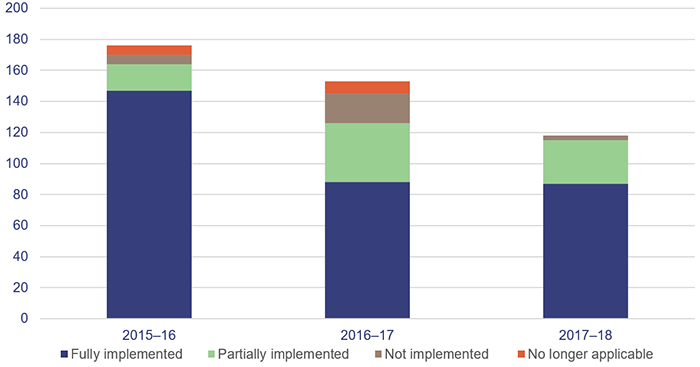
Queensland Audit Office using data self-reported by entities.
Status of implementation by year
Entities reported they had implemented most of the recommendations we issued to them in 2015–16 and 2017–18, but not as many in 2016–17.
Figure 2B lists the status of the recommendations issued to individual entities for each financial year.
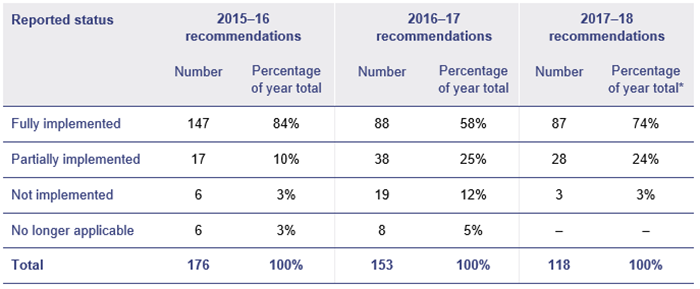
Note: * Percentage total for 2017–18 does not add to 100 per cent due to rounding.
Queensland Audit Office using data self-reported by entities.
Recommendations assessed as no longer applicable
Entities reported that six recommendations from 2015–16 and eight from 2016–17 were no longer applicable. The most common reason was due to changes in government policy.
For example, Queensland Corrective Services reported that all recommendations from Management of privately operated prisons (Report 11: 2015–16) were no longer applicable because, after we issued our report, the Queensland Government moved responsibility for privately operated prisons back to public operation.
Similarly, the former Public Safety Business Agency reported that recommendations from Criminal justice system—reliability and integration of data (Report 14: 2016–17) were no longer applicable because it was being disbanded, and responsibility for crime statistics had shifted back to the Queensland Police Service. The Queensland Police Service reported fully implementing five of these recommendations and partially implementing the other.
In our report Criminal justice system—prison sentences (Report 4: 2016–17), we recommended that the Department of Justice and Attorney-General, in collaboration with the Queensland Police Service, assess whether relevant sentencing legislation should be reviewed to reduce the complexity of sentence calculations. The Queensland Police Service and Queensland Corrective Services assessed this recommendation as no longer applicable because it was addressed to the Department of Justice and Attorney‑General and not specifically within their mandate to implement. The Department of Justice and Attorney‑General reported amending the Penalties and Sentences Act 1992 to reduce the complexity of sentence calculations in response to this recommendation.
We agree that these recommendations are no longer applicable.
Status of implementation by report
Reports to parliament with no outstanding recommendations
Entities reported fully implementing all recommendations from 15 reports tabled in parliament between 2015–16 and 2017–18 or assessed the remaining recommendations as no longer applicable.
Figure 2C shows the reports that have no outstanding recommendations.
|
Tabling year |
Report title |
Entity |
|
|
2015–16 |
Agricultural science research, development and extension programs and projects |
Department of Agriculture and Fisheries |
|
|
Cloud computing |
Multiple entities |
||
|
Early childhood education |
Department of Education |
||
|
Financial risk management practices at Energex |
Energy Queensland Limited and Queensland Treasury |
||
|
Transport infrastructure projects |
Department of Transport and Main Roads |
||
|
Management of privately operated prisons |
Multiple entities |
||
| Road safety - traffic cameras | Multiple entities | ||
|
Royalties for the regions |
Multiple entities |
||
|
2016–17 |
Audit of Aurukun school partnership arrangement |
Department of Education |
|
|
Biosecurity Queensland's management of agricultural pests and diseases |
Department of Agriculture and Fisheries |
||
|
Government advertising |
Multiple entities |
||
|
Strategic procurement |
Multiple entities |
||
|
2017–18 |
Fraud risk management |
Multiple entities |
|
|
Investing for Success |
Department of Education |
||
|
Managing the mental health of Queensland Police employees |
Queensland Police Service |
||
Queensland Audit Office using data self-reported by entities.
The remaining 17 reports to parliament have outstanding recommendations.
In the following section, we break down the reports with outstanding recommendations by year and include an example for each. We have chosen the examples either based on the number of outstanding recommendations related to them, or the important themes from these reports.
2015–16 reports to parliament with outstanding recommendations
Entities reported that only three reports to parliament from 2015–16 have outstanding recommendations. These are shown in Figure 2D.
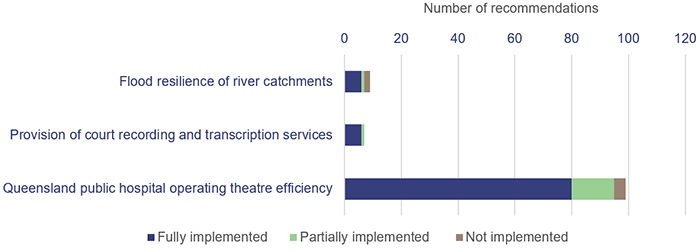
Queensland Audit Office using data self-reported by entities.
Our report on public hospital operating theatre efficiency had the highest number of outstanding recommendations of the three reports. We discuss the status of these under the hospital and health services section later in this report. Our audit on flood resilience of river catchments had the next highest number of outstanding recommendations.
Flood resilience of river catchments
In Flood resilience of river catchments (Report 16: 2015–16), we examined flood resilience activities in the Bremer, Lockyer, Mid and Upper Brisbane river catchments. The Department of Regional Development, Manufacturing and Water and two of the four councils we audited reported good progress in implementing the recommendations from this audit. The Lockyer Valley Regional Council reported that it was still in the process of developing a local flood plain management plan but expected it to be complete by 30 June 2021.
The Scenic Rim Regional Council was the only council that reported not implementing any of the recommendations issued to it. It had made no progress in developing a flood plain management plan or in working with the Department of Regional Development, Manufacturing and Water to regulate levee banks effectively and economically.
Despite receiving these recommendations over five years ago, the council reported that it had limited awareness of them and had not taken any real action to address them. It did not explain why. Given the risks that floods can present to Queensland communities, it is important that the council prioritises the implementation of these recommendations.
2016–17 reports to parliament with outstanding recommendations
Entities reported that eight reports to parliament have outstanding recommendations. These are shown in Figure 2E.
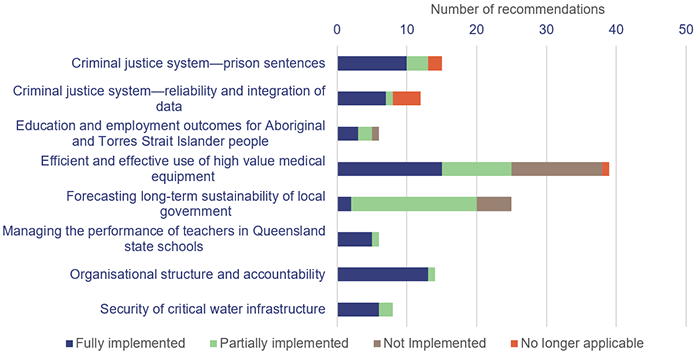
Queensland Audit Office using data self-reported by entities.
Our reports on high value medical equipment and the sustainability of local government had the highest number of outstanding recommendations. We discuss the status of these under the hospital and health services and local government sections later in this report.
In both our financial and performance audits, we see entities that do not possess adequate controls for protecting their systems and information—whether it be financial systems or computer systems controlling operational infrastructure. In our recent State entities 2020 (Report 13: 2020–21) report, we highlighted that this continues to be the area where we identify most issues, particularly in relation to user access to systems.
Protecting public sector systems and information
The protection of government systems and information is critical to Queensland’s economic and security interests. Cyber security threats and attacks on public sector entities are increasing, both in frequency and severity. These attacks happen more often when high profile events occur, such as the Group of Twenty (G20) forum and Commonwealth and Olympic Games.
The risk to government is significant if entities fail to implement appropriate controls. As such, the security of public sector systems and information has been, and will continue to be, a key focus for our office.
Figure 2F shows the three performance audit reports to parliament we have tabled on the security of public sector systems and information.

Queensland Audit Office www.qao.qld.gov.au.
In Security of critical water infrastructure (Report 19: 2016–17) we assessed whether the systems used to operate, manage, and monitor water infrastructure were secure, and if effective processes were in place to recover from adverse events. We made eight recommendations to four entities.
We did not name the entities involved in this audit because:
- we did not want to compromise their security by publicly identifying their security vulnerabilities
- we wanted all entities, not just those included in the audit, to consider the recommendations and where necessary, take action to strengthen their systems.
We recommended that the entities we audited improve oversight, identification, and monitoring of information technology risks and cyber threats to water control systems. Two of the entities we audited reported only partially implementing this recommendation. They said they have strengthened their water control systems, and they plan to undertake additional work to test their controls and enhance the security of their systems.
2017–18 reports to parliament with outstanding recommendations
Entities reported that six reports to parliament have outstanding recommendations. These are shown in Figure 2G.
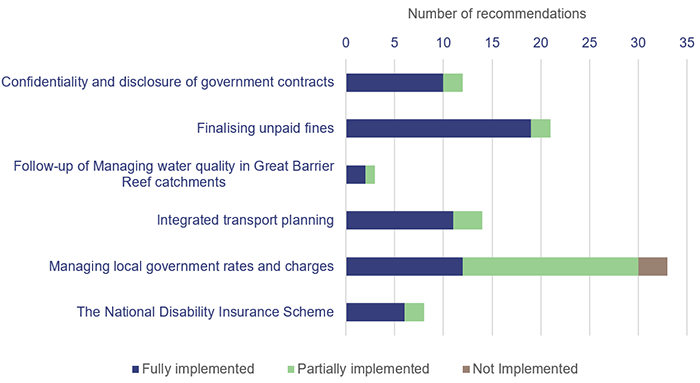
Queensland Audit Office using data self-reported by entities.
Our report on managing local government rates and charges had the highest number of outstanding recommendations. We discuss the status of its recommendations under the local government section later in this report.
In our audits on Finalising unpaid fines (Report 10: 2017–18) and Integrated transport planning (Report 4: 2017–18), and in several other audits we have undertaken, we found entities are not using their data well enough.
Entities can make better use of their data
Entities possess valuable sources of data, but in many cases it is not easily accessible or well understood. Some are not analysing their data for insights for strategy and policy decisions.
In Integrated transport planning we highlighted the importance of having:
- appropriate systems to collect, record, and analyse relevant data
- experienced staff to analyse and provide insights into data.
In most cases, entities reported good progress in implementing these recommendations. The Department of Transport and Main Roads said it had fully implemented seven of its 10 recommendations. It reported that the remaining recommendations were partially implemented, and it still needed to develop an integrated performance report to better analyse and track its progress.
A lack of integration across systems can create a barrier to having a complete view of performance. It can also restrict the timely sharing of information. Interoperability, which is enabling systems to automatically share real-time (immediate) data and interpret incoming data, can be valuable—but costly.
Integrating systems can be a more practical solution. It involves connecting applications so one system (for example, a police incident system) can access another one (for example, a health medical system). Multiple systems within an entity or across entities can be integrated.
In Finalising unpaid fines we found some entities could better integrate their systems to share information. The four entities we audited reported implementing the recommendation focused on this.
Despite the good progress reported, entities can make better use of their data. In more recent reports, we have continued to find that entities are not proactively using their data in decision making and that their systems contain incomplete and out-of-date information. Our society is now more data-driven than ever before. The public sector needs to take advantage of the opportunities its data holds to deliver more efficient and effective public services.
Progress of implementation by entity type
In the following pages, we provide analysis on reported progress in implementing recommendations by:
- departments
- hospital and health services (HHSs)
- local governments
- other entities.
Departments
Most departments reported good progress in implementing the 250 recommendations addressed to them from our 32 reports.
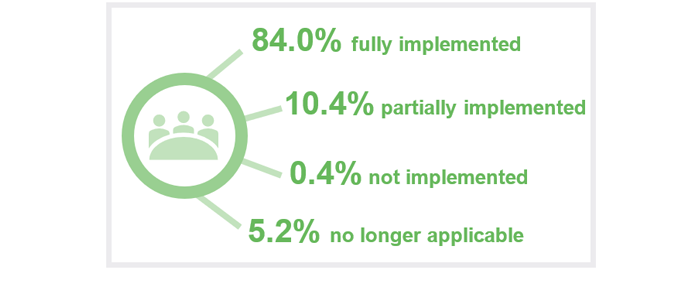
Queensland Audit Office.
The following eight departments reported implementing all recommendations:
- Department of Agriculture and Fisheries
- Department of Communities, Housing and Digital Economy
- Department of Health
- Department of the Premier and Cabinet
- Department of Regional Development, Manufacturing and Water
- Public Service Commission
- Queensland Fire and Emergency Services
- Queensland Treasury.
The Department of Energy and Public Works and the former Public Safety Business Agency (abolished 1 July 2021) reported implementing most of their recommendations and assessed that the remaining recommendations were no longer applicable.
The remaining nine departments had not implemented all of their recommendations.
Figure 2I shows the departments that reported having partially implemented and/or not implemented recommendations.
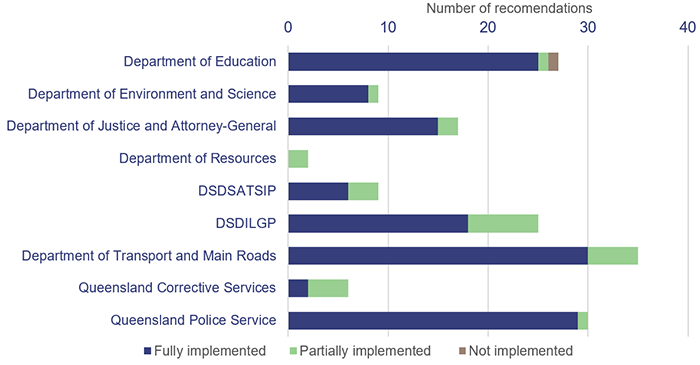
Notes: DSDSATSIP—the Department of Seniors, Disability Services and Aboriginal and Torres Strait Islander Partnerships; DSDILGP—the Department of State Development, Infrastructure, Local Government and Planning.
Queensland Audit Office using data self-reported by entities.
Audit committees should hold management to account by challenging whether it has effectively implemented recommendations in a timely manner. To do this, their independence is critical. Too often, we find audit committees of departments with large numbers of internal members (meaning staff employed by the entity), making it difficult to independently challenge management’s actions.
Some departments, like the Department of Education, provided detailed comments explaining the action they had taken in relation to our recommendations and the outcomes of those actions. Others lacked sufficient detail to determine what action they had taken.
Departments provided us with examples indicating they were working collaboratively to implement our recommendations. For example, in Criminal justice system—prison sentences (Report 4: 2016–17) we recommended that the Department of Justice and Attorney-General, in collaboration with the Queensland Police Service, better integrate sentencing administration processes and quality assurance to reduce the risk of error. In response, the entities reported working together to develop and implement an action plan to address this recommendation. This included setting up a reference group to monitor and track the implementation of recommendations.
Not only is it important that entities develop and implement their action plans—it is also important that they evaluate the outcome of their actions. The entities reported their actions improved the quality of court orders and the timely exchange of important sentencing information. At this stage we have not yet audited this to assess the effectiveness of their implementation.
Hospital and health services (HHSs)
HHSs reported varied progress in implementing the 128 recommendations we made to them.
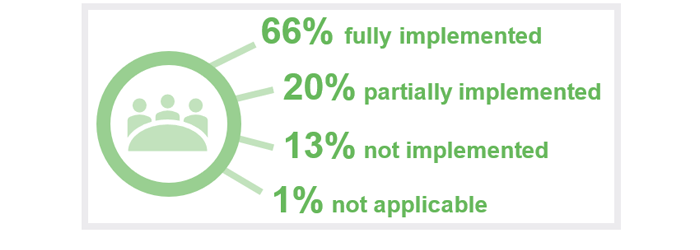
Queensland Audit Office.
The two reports relevant to them were:
- Queensland public hospital operating theatre efficiency (Report 15: 2015–16)
- Efficient and effective use of high value medical equipment (Report 10: 2016–17).
We made recommendations to all 16 HHSs from these two reports. However, we only analysed responses from 12 HHSs.
For the theatre efficiency report we analysed the responses from 12 HHSs that perform more than 300 elective surgeries each quarter. We excluded four HHSs that perform very little elective surgery from our analysis. For the high value medical equipment report we analysed the responses of seven HHSs that have five or more pieces of high value equipment (meaning medical equipment with an acquisition value of $1 million or more). We excluded those HHSs that have no high value medical equipment, or very few pieces, from our analysis.
Figure 2K shows the reported status of recommendations by the 12 HHSs.
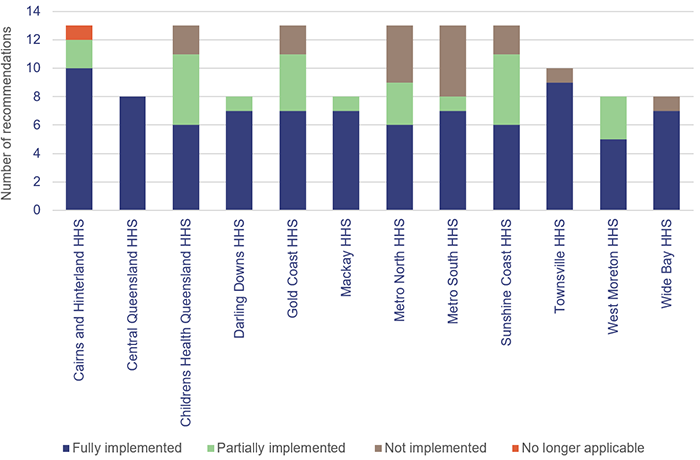
Queensland Audit Office using data self-reported by entities.
We made eight recommendations in our report on high value medical equipment. Seven of the eight recommendations were addressed to the Department of Health (the department) and five of the eight to all HHSs. At the time we issued the report, we only received a formal response from four of the 16 HHSs stating whether they agreed with the recommendations. The department and three HHSs agreed with all, but Townsville HHS disagreed with three of them, because it believed they were not practical and were unlikely to add value. We did not ask Townsville HHS to self-assess its progress in implementing these recommendations.
The department and the seven HHSs reported varied progress in implementing the recommendations from this report.
The department reported implementing all of them, but it did not explain the action it had taken for most or the outcome of its actions for any of them. The seven HHSs reported implementing only 25 per cent (eight) of the 32 recommendations (this does not include the three recommendations that Townsville HHS did not agree with).
We found conflicting information in the responses we received from the department and some HHSs. For example, we recommended that the department and HHSs collaborate to consider standardising waitlist templates, so all HHSs could capture and report on the same information—to enhance planning for high value medical equipment.
The department reported fully implementing this recommendation. It advised us that a Medical Equipment Renewal Project was established after we tabled our report. It advised that a steering committee for this project, which included the department and the seven HHSs, considered all the recommendations we made including the recommendation on considering standardising waitlist templates. The department did not advise in its response the outcome of those considerations. Four of the HHSs reported not implementing this recommendation, one reported partially implementing it, and the other assessed it as no longer applicable. Townsville HHS did not agree with this recommendation and therefore did not provide a response.
As mentioned in our recent report on Planning for sustainable health services (Report 16: 2020–21), there is a need for greater collaboration between the department and HHSs. The importance of this was a prominent theme in the advice provided by an expert panel to the department in March 2019 on Queensland Health’s governance framework. It emphasised that the department and the HHSs have a role as stewards and leaders of the health system. It also recommended that the department better collaborate with HHSs to deliver coordinated, timely, streamlined, and respectful engagement with the HHSs on relevant strategic, operational, and performance matters.
HHSs reported implementing more than 80 per cent of recommendations from our report on Queensland public hospital operating theatre efficiency. For many of the outstanding recommendations, they reported acting to improve the efficiency of their theatres, but acknowledged they still have more to do.
Local governments
We tabled three reports to parliament that included 56 recommendations addressed to all local governments:
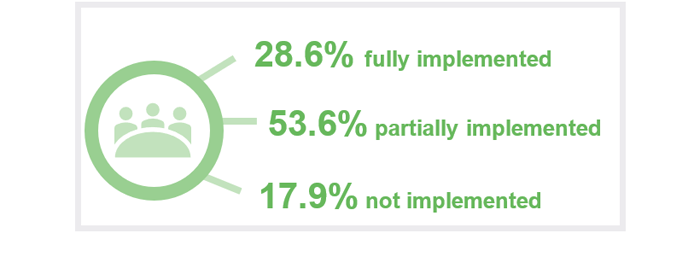
Note: The above percentages do not add to 100 per cent due to rounding.
Queensland Audit Office.
We only sought and analysed responses from those councils that we included in the scope of these audits (meaning those that we closely examined). The 13 local governments (councils) we made recommendations to reported that they had only implemented 28.6 per cent (16) of the 56 recommendations issued between 2015–16 and 2017–18. They did not identify any recommendations that were no longer applicable.
Figure 2M shows the reported status of recommendations by selected councils. Councils vary widely in their size and location, and in the range of community services they provide. To enable comparison, we have grouped them into five common segments used by the Local Government Association of Queensland: Coastal, Resources, Rural/Regional, Rural/Remote, and South East Queensland.
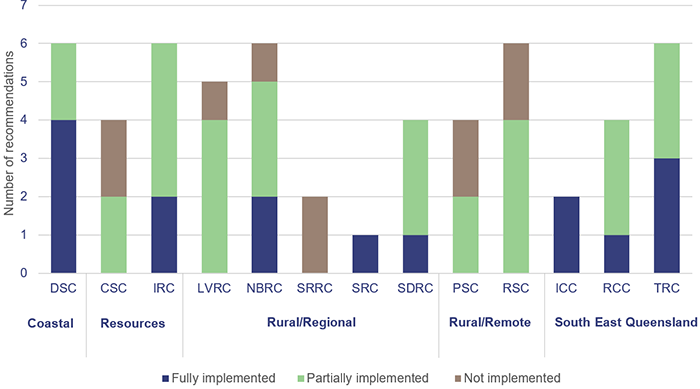
Notes: DSC—Douglas Shire Council; CSC—Cook Shire Council; IRC—Isaac Regional Council; LVRC—Lockyer Valley Regional Council; NBRC—North Burnett Regional Council; SRRC—Scenic Rim Regional Council; SRC—Somerset Regional Council; SDRC—Southern Downs Regional Council; PSC—Paroo Shire Council; RSC—Richmond Shire Council; ICC—Ipswich City Council; RCC—Redland City Council; TRC—Toowoomba Regional Council.
Queensland Audit Office using data self-reported by entities.
Local government sustainability
A sustainable council is one that is economically and environmentally sound, and socially responsible. A key component of sustainability is the council’s ability to generate revenue and become more financially independent. With uncertainty around future revenue sources, councils need to plan effectively to ensure their long-term sustainability.
Each year we examine the sustainability of councils as part of our financial audits. For many years, we have seen sustainability as one of the biggest risks to the sector. As a result, we have maintained a continued focus on it, both in our annual local government financial audits and through regular performance audits. We have sought to ensure councils, regulators, and funding bodies maintain an awareness of this risk. By being well informed, they can take the right action now to ensure the long-term success of the sector.
We reported on local governments’ latest financial sustainability ratios in our Local government 2020 (Report 17: 2020–21) report and in our 2020 local government dashboard.
In addition, we have undertaken a series of performance audits examining councils’ financial sustainability. These are shown in Figure 2N.

Queensland Audit Office www.qao.qld.gov.au.
We have started a fourth audit examining whether local governments are effectively managing their infrastructure assets to maximise service potential, while minimising the total cost of owning these assets. We plan to table this in 2022. We also intend to undertake a fifth local government sustainability audit in 2023–24 to examine the sector’s progress in meeting its sustainability challenges.
Forecasting long-term sustainability of local government was the first in our series of reports on this issue. Councils reported only implementing eight per cent (two) of the 25 recommendations from this. They partially implemented 72 per cent (18) and did not implement 20 per cent (five). Some local governments did not explain why they had not implemented recommendations. Others reported that they lacked adequate resources and support to do so.
For example, we recommended that local governments improve the quality of their financial plans by explaining their financial forecasts and how they intend to financially manage the council and its long-life assets. Cook Shire Council recognised the merits of this recommendation but reported that it did not have adequate resources to implement it. We acknowledge the challenges for some remote councils. These councils often have large land masses with significant infrastructure they need to maintain despite low and sometimes declining populations. These communities can often struggle to attract and retain specialist skills. Natural disasters can also make it hard for some councils to plan over the long term. Despite these challenges, the councils still need to provide essential services to their communities—water, wastewater/sewerage, roads, and waste collection.
Long-term planning and planning for infrastructure replacement is a cornerstone of financial sustainability. Local governments can pay more if they do not plan effectively, because they may repair or renew assets at sub-optimal times, resulting in increased whole-of-life costs. Ultimately, this makes them less sustainable.
Local governments also reported limited progress in implementing recommendations from Managing local government rates and charges. They reported 63 per cent (19) of the 30 recommendations from this report as outstanding.
In it, we addressed six recommendations to five local governments. Richmond Shire Council had the highest number of outstanding recommendations of the local governments. It had partially implemented four recommendations and not implemented the remaining two. Of the five local governments, Richmond Shire Council is the only one that does not have an audit and risk committee. These committees play a critical role in helping entities monitor their performance and manage risk, including in implementing audit recommendations.
Other entities
We also make recommendations to statutory bodies and government owned corporations. We published three reports that included seven recommendations addressed to Energy Queensland Limited, Queensland Building and Construction Commission, and Queensland Rail.
The entities reported implementing all seven of the recommendations we issued to them. They detailed the actions they had taken and the outcomes of their actions for each recommendation.

Status of Auditor-General's recommendations dashboard
This Queensland Audit Office interactive dashboard allows you to explore entities’ self-assessed progress based on your area of interest or responsibility. You can search by year, report, entity, parliamentary committee, and implementation status.


